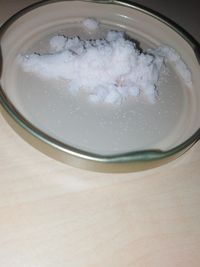Manganese(II) chloride

| |
| Names | |
|---|---|
| IUPAC name
Manganese(II) chloride
| |
| Other names
Manganese bichloride
Manganese dichloride Manganous chloride Scacchite | |
| Properties | |
| MnCl2 | |
| Molar mass | 125.844 g/mol (anhydrous) 161.874 g/mol (dihydrate) 197.91 g/mol (tetrahydrate) |
| Appearance | Off-white solid (anhydrous) Pink solid (hydrated) |
| Odor | Odorless |
| Density | 2.977 g/cm3 (anhydrous) 2.27 g/cm3 (dihydrate) 2.01 g/cm3 (tetrahydrate) |
| Melting point | anhydrous 654 °C (1,209 °F; 927 K) dihydrate 135 °C (275 °F; 408 K) (decomposes) tetrahydrate 58 °C (136 °F; 331 K) (decomposes) |
| Boiling point | 1,225 °C (2,237 °F; 1,498 K) |
| 63.4 g/100 ml (0 °C) 73.9 g/100 ml (20 °C) 88.5 g/100 ml (40 °C) 123.8 g/100 ml (100 °C) | |
| Solubility | Soluble in ethanol, methanol Slightly soluble in pyridine Insoluble in ethers, halocarbons, hydrocarbons |
| Vapor pressure | ~0 mmHg |
| Hazards | |
| Safety data sheet | Sigma-Aldrich (anhydrous) Sigma-Aldrich (tetrahydrate) |
| Flash point | Non-flammable |
| Lethal dose or concentration (LD, LC): | |
| LD50 (Median dose)
|
250-275 mg/kg (rat, oral) 1,715 mg/kg (mouse, oral) |
| Related compounds | |
| Related compounds
|
Chromium(III) chloride Iron(II) chloride |
| Except where otherwise noted, data are given for materials in their standard state (at 25 °C [77 °F], 100 kPa). | |
| Infobox references | |
Manganese(II) chloride is the chemical compound with the formula MnCl2, a salt of manganese metal. It is available as anhydrous, monohydrate, dihydrate and tetrahydrate.
Manganese(II) chloride occurs in nature as the rare mineral scacchite, first identified in the volcanic fumaroles of Vesuvius.
Contents
Properties
Chemical
Manganese(II) chloride is a weak Lewis acid.
Addition of organic ligands to solutions of manganese(II) and oxidation in air will give Mn(III) complexes.
Physical
Manganous chloride is an odorless pink solid, soluble in water, but insoluble in most organic solvents.
Availability
Manganese(II) chloride is sold by chemical suppliers.
Preparation
Manganese chloride is produced by treating manganese dioxide with concentrated hydrochloric acid.
- MnO2 + 4 HCl → MnCl2 + 2 H2O + Cl2
Since the reaction releases chlorine gas, this must be done outside or in a fume hood.
Chlorine-free routes involve adding the hydrochloric acid to manganese metal or manganese carbonate/hydroxide.
- Mn + 2 HCl → MnCl2 + H2
- Mn(OH)2 + 2 HCl → MnCl2 + 2 H2O
- MnCO3 + 2 HCl → MnCl2 + H2O + CO2
Manganese carbonate can be obtained by reacting manganese dioxide with oxalic acid.
The double replacement reaction between manganese(II) sulfate and calcium chloride will give manganese dichloride, while calcium sulfate precipitates out of the reaction. Manganese sulfate can be easily obtained by bubbling sulfur dioxide in an aqueous suspension of manganese dioxide or just adding manganese dioxide to a cooled aq. solution of sulfur dioxide.
- MnSO4 + CaCl2 → MnCl2 + CaSO4
The resulting suspension is filtered to remove the insoluble calcium sulfate. The filtered MnCl2 solution is placed on a heating bath, where water is evaporated to concentrate it. The concentrated solution is cooled to crystallize the compound. If the source of manganese dioxide used is batteries, multiple recrystallizations are required to remove iron impurities. Alternatively, heating the resulting chloride mixture dry causes mainly the iron compounds to form oxides. Redissolution in water, followed by another filtration can remove a large proportion of the iron contamination.[1]
All the above procedures will give the hydrated form of this salt. To obtain the anhydrous form, the compound is heated in an oxygen-less or free atmosphere, like under inert gas or an organic solvent like methanol, or in a stream of hydrogen chloride.
A route to obtain the anhydrous form involves reacting manganese metal with dry hydrogen chloride or chlorine gas at high temperatures.
- Mn + 2 HCl → MnCl2 + H2
- Mn + Cl2 → MnCl2
Projects
- Make dry cell batteries
- Make Mn coordination complexes
- Make sodium permanganate
- Make manganese dioxide
Handling
Safety
Manganese dichloride is harmful in ingested. Long-term exposure to manganese dust or compounds will lead to manganese poisoning or manganism.
Storage
Manganese(II) chloride doesn't have special storage conditions, any clean plastic or glass container is sufficient.
Disposal
Manganese(II) chloride should be precipitated to the less soluble manganese dioxide and then sent to waste disposal centers. Waste batteries centers might also pick up manganese waste.
Diluted manganese chloride can be used as source of manganese for plants.